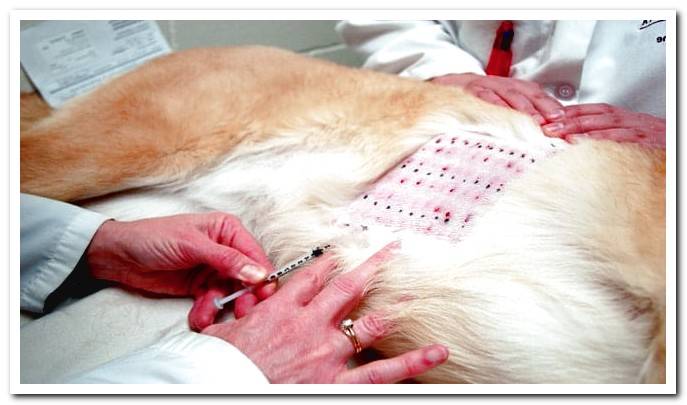
Skin disorders are one of the most frequent reasons why we go to the vet with the dog. The main symptoms that we can observe are itching, hair loss or redness of the skin.
When our dog scratches more than normal, the first thing we think is that he may have fleas or an allergy to something in the environment. But did you know that itching is the main symptom of food allergies?
Next, we will learn a little more about this type of food-related allergies, simply answering a series of questions.
- You may also like: Insect-based dog food
Index of contents
- 1 What is a food allergy?
- 2 Why do some dogs have food allergies?
- 3 Which dogs tend to have a food allergy?
- 4 How do I know if my dog has a food allergy?
- 4.1 What to do after the elimination diet?
- 4.2 How do you know which ingredient you are allergic to?
What is a food allergy?
A food allergy is an adverse reaction to a certain food that produces cutaneous and / or digestive symptoms in the dog. When a dog has a food allergy, what is usually observed is that it scratches more than usual.
Gastrointestinal symptoms such as diarrhea, less consistent stools, gas, and even vomiting may also appear. However, these digestive signs they are seen only in 20% of cases.
In allergic dogs, the skin may be reddened and show scratching lesions. The distribution of these lesions is variable, but they are frequently observed in the legs, armpits, groin, perineum, face, ears and neck. In addition, these dogs often suffer from otitis.

Why do some dogs have food allergies?
In the animals that do not present alterations of the health and without food allergies, the food is ingested, digested and assimilated through the digestive system without causing abnormal reactions.
What happens in a dog with food allergy, is that when eating a certain food your body identifies it as something potentially harmful. Its defensive (immune) system reacts releasing a series of substances that will be responsible for the appearance of allergy symptoms in the animal.
Allergies can be considered a failure in the animal’s immune system, since its defenses react to something that is not really harmful to the body, food.
Importantly, any food eaten can cause an allergic reaction, but the part of the food that causes this reaction is protein. To date, no food allergy to carbohydrates or fats has been described.
In general, the foods that are most likely to cause a food allergy are those with a high protein content, and are consumed more frequently.
Between 35-50% of dogs with food allergies are allergic to more than one ingredient, the most common being: beef, dairy products, chicken, corn, wheat, fish or soy.

Which dogs tend to have a food allergy?
Food allergies are not associated with a specific race, age or sex. It is an individual pathology and any dog can suffer or develop it throughout its life. The age of appearance of the first signs is variable, and can range from four months to eleven years of age.
How do I know if my dog has a food allergy?
Food allergies are difficult to identify, since their symptoms are similar to those of other diseases, so it is important to go to the vet to confirm that, in fact, our dog’s signs are due to a food allergy.
To determine if a dog has a food allergy, the first thing the vet will do is rule out other health problems such as parasites, infections, etc.
Definitive diagnosis is achieved by an elimination diet, which consists of feeding the dog with an allergen-free or protein-based food that it has not consumed before.
There are two types of elimination diets: those based on novel proteins (proteins that are not normally used in dog food, for example, deer, rabbit or insects) and those that are made up of hydrolyzed proteins, that is, proteins that have been fragmented into very small particles that will not be detected by the animal’s immune system.
The time necessary to confirm if there is a food allergy is at least 6 weeks, so during this period it is very important that the dog eat only the elimination diet. In general, improvement of symptoms should be observed after 3-4 weeks of administration of this diet.
What to do after the elimination diet?
Animals that show a complete improvement in symptoms with the elimination diet must perform an exposure challenge test, which consists of feeding them again with the original diet they consumed before treatment. If the allergy signs reappear when you return to your usual feed, we can confirm that our dog has a food allergy.
How do you know which ingredient you are allergic to?
If we want to go one step further in the diagnosis and know which ingredient you are allergic to, you can carry out the challenge test by exposure, testing the ingredients of your previous diet one by one to determine which one is causing the itch.
To do this, we identify the proteins that your regular diet contains by reviewing the list of ingredients. Every week, we add one of those proteins to the elimination diet and for 7 days we observe if an adverse reaction occurs. If the itching does not reappear in this period, the food allergy to that specific protein is ruled out.
For example, if our dog’s usual feed has chicken and corn as ingredients, we can add pieces of cooked chicken breast to the hydrolyzed feed the first week and see if symptoms appear again. The following week, we would mix the feed with cooked corn and observe if there is an adverse reaction.
As you can see, make the complete diagnosis of this pathology takes time and patience This is why many owners decide not to carry out the challenge test and simply continue feeding their pet a hydrolyzed or novel protein feed for life. Knowing what ingredient / s our dog is allergic to, allows us to feed him with any diet that does not contain these substances.
